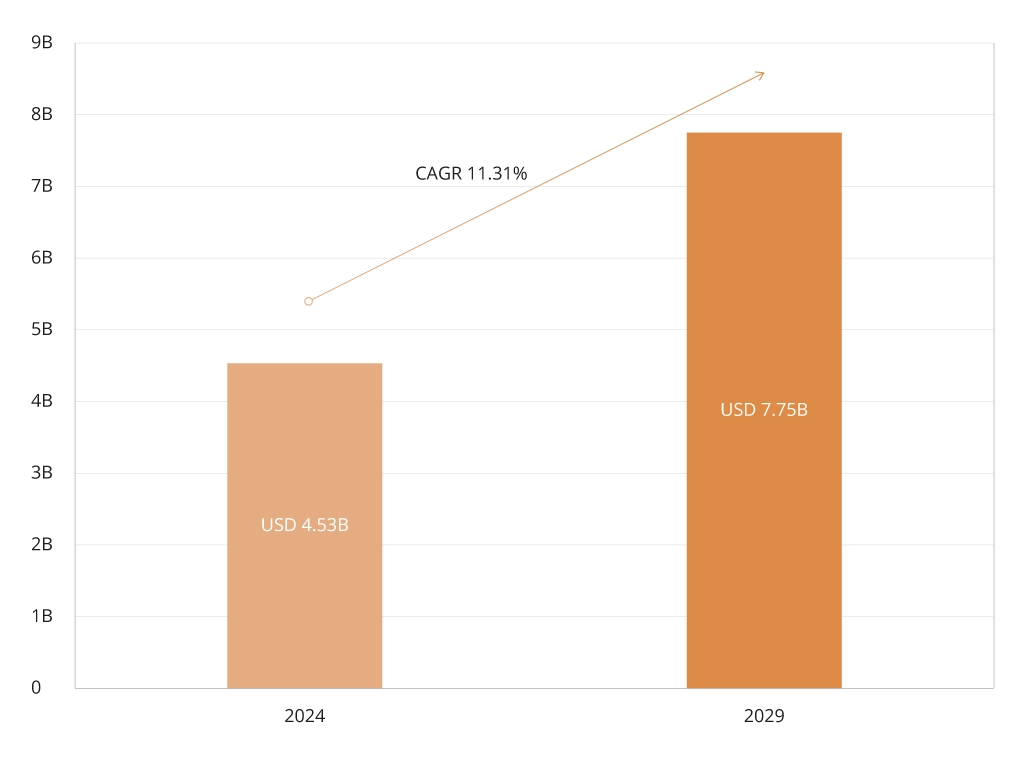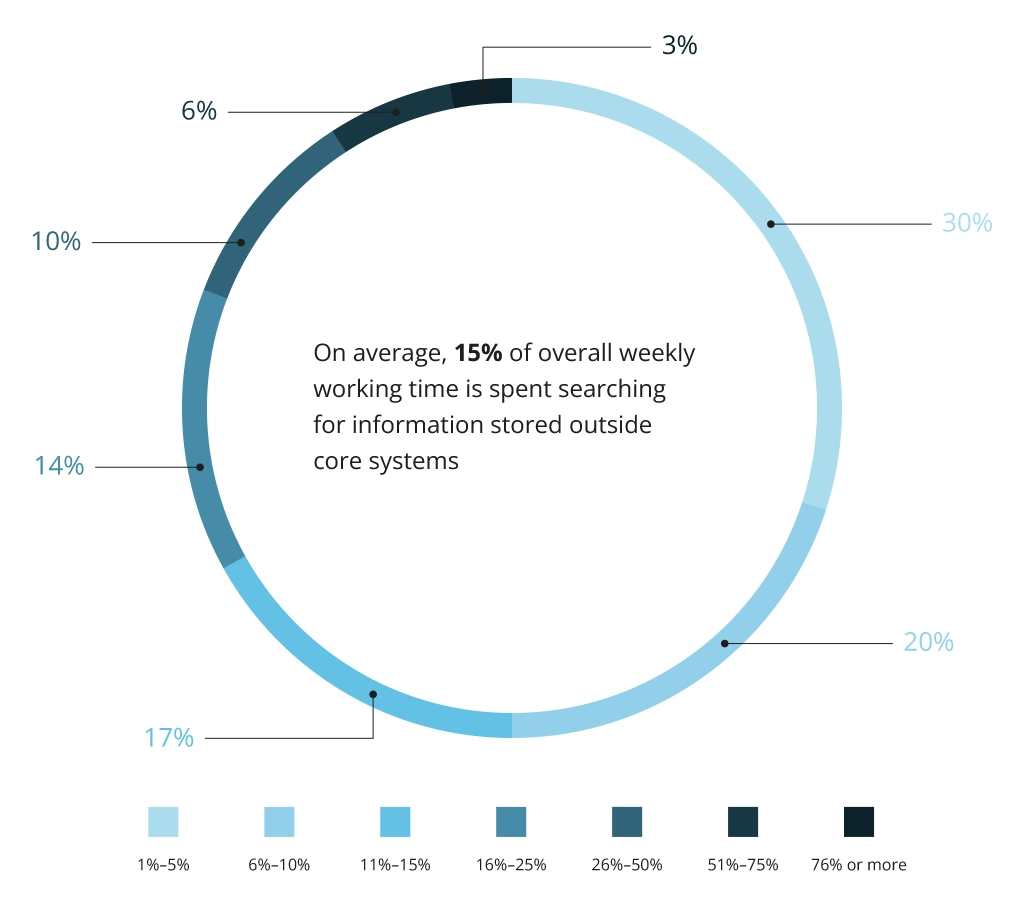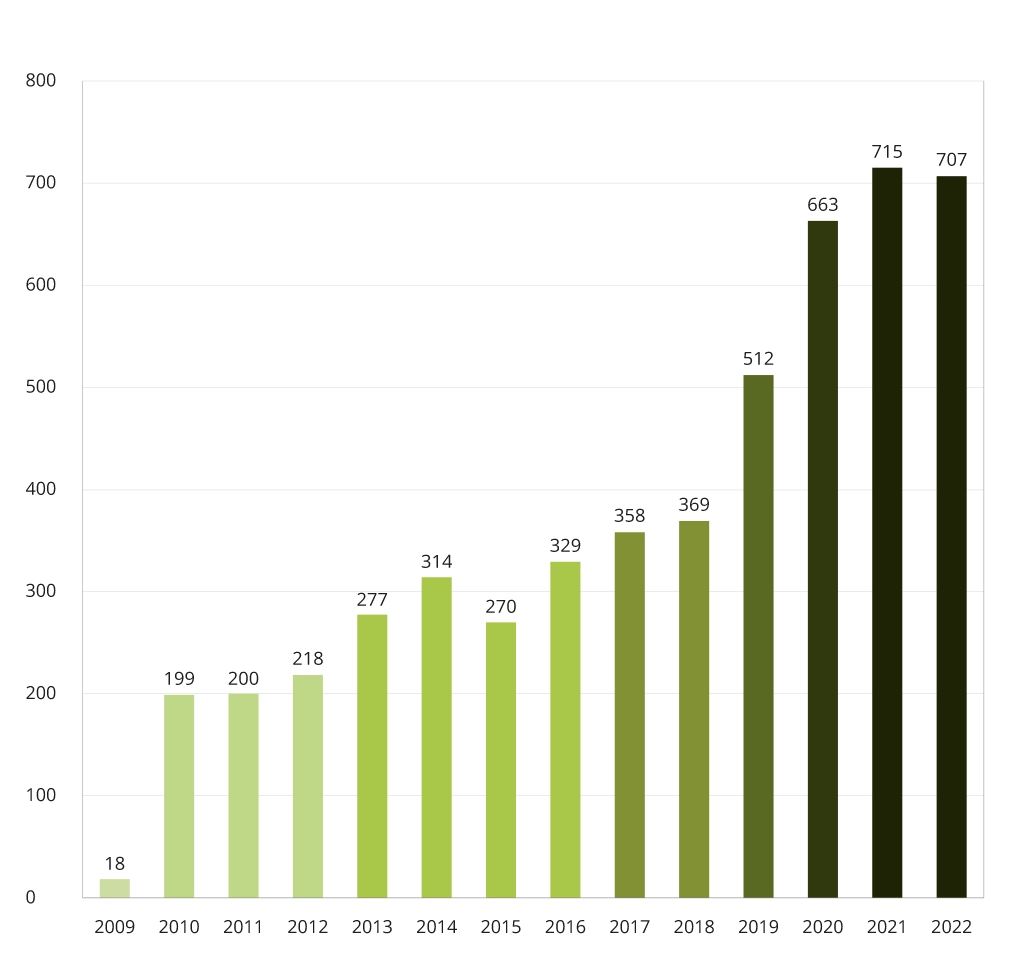6 Data Challenges of Achieving Interoperability in Healthcare
Today, less than 60% of the data generated by healthcare organizations is utilized for making intelligent business decisions. Such data silos prevent seamless information exchange and hinder efforts to achieve true interoperability in healthcare. The lack of interoperability has a ripple effect: it can lead to errors in patient care, inflate costs, and hamper public health initiatives. So, how can we break down data silos and create a more connected healthcare ecosystem? This article explores the data challenges that stand in the way and examines potential solutions for a more efficient and effective future.
Explore intelligent automation use cases in Healthcare.
What Is Interoperability?
According to HIMMS, interoperability in healthcare refers to the capability of different information systems, devices, and applications to access, exchange, integrate, and cooperatively use data in a coordinated manner across organizational, regional, and national boundaries.
Health data exchange frameworks, application interfaces, and standards enable secure and appropriate data sharing across all levels of care and with all relevant stakeholders, including patients.
Healthcare interoperability functions on four different levels:
- Level 1. Foundational: Establishes basic requirements for systems or applications to securely communicate and exchange data.
- Level 2. Structural: Defines the format, syntax, and organization of data exchange, including the interpretation of data fields.
- Level 3. Semantic: Ensures a common understanding of the data by using standardized definitions from publicly available value sets and coding vocabularies.
- Level 4. Organizational: Addresses the governance, policy, social, legal, and organizational factors to facilitate secure, seamless, and timely data communication and use across and within organizations.
The Current State of the Market and Regulations
The global healthcare interoperability solutions market is on a significant growth trajectory. In 2024, it is estimated at $4.53 billion, with projections reaching $7.75 billion by 2029. This represents a robust compound annual growth rate (CAGR) of 11.31% over the forecast period.
To understand this growth better, let's examine the specific regulatory measures and market dynamics driving interoperability in the United States and the European Union.
U.S. Regulations
In the United States, significant strides have been made towards improving interoperability through key regulatory measures:
- 21st Century Cures Act (2016). Signed by President Obama, this act mandates that Electronic Health Record (EHR) systems provide a patient-facing API to maintain federal certification. This aims to ensure patient data accessibility and reduce information blocking.
- CMS Interoperability and Patient Access Rule (2020). Issued by the Centers for Medicaid & Medicare Services (CMS), this rule requires health plans and providers receiving federal funds to facilitate easier access to health information, promoting data sharing and reducing silos.
A survey of the top 50 health systems in the United States revealed that over half of these organizations planned to increase their spending on interoperability by 5% to 20% in 2023 compared to their expenditures in 2022. Notably, none of the surveyed organizations intended to reduce their interoperability budgets.
EU Digital Health Strategy
The European Union has also implemented robust measures to enhance interoperability:
- European Health Data Space (EHDS). This initiative seeks to drive innovation and improve cross-border data exchange within the EU. A central aspect involves creating a standardized European Electronic Health Record Exchange Format to enable the smooth sharing of health information among EU member states.
- Interoperable Europe Act (2024). Effective April 2024, this act enhances cross-border interoperability and cooperation in the public sector. It introduces a framework for public administrations to collaborate on interoperability solutions, supported by an Interoperable Europe Board, mandatory interoperability assessments, and an 'Interoperable Europe Portal' for shared solutions.
The Europe Healthcare Interoperability Solutions Market is projected to grow at a CAGR of 12.6% from 2023 to 2029. These technologies are expected to reduce costs from delayed treatments and diagnoses by providing real-time data access. Future healthcare will rely on seamless data sharing and medical device integration.
Currently focused on curative care, the market is shifting towards preventive care through data-driven technologies. This growth is supported by patient-centered care programs and government efforts to promote interoperability, all aiming to improve patient care and safety.
Why Is Interoperability Important in Healthcare?
Interoperability in healthcare is essential for both patients and healthcare providers as it greatly reduces redundant administrative tasks. Here are the main benefits of interoperability in healthcare.
Improved Care Coordination
Currently, only 7% of healthcare providers claimed that all necessary patient information is stored in their EHR. Therefore, employees spend on average 15% of the workweek locating information outside of their core systems. This highlights how important it is to streamline healthcare data access and integration.
In this case, interoperability is essential for better care coordination among healthcare providers. It allows clinicians to easily access a patient's complete health records, reducing the need to repeat tests and preventing treatment conflicts. This leads to more accurate diagnoses, fewer mistakes, and safer patient care.
Elevated Performance
Interoperability significantly enhances the performance of healthcare organizations by simplifying data integration and analysis. When data flows effortlessly between systems, healthcare providers can identify trends, evaluate past performance, and make data-driven improvements in patient care. This leads to greater operational efficiency, reduced errors, and optimized resource utilization, ultimately resulting in more precise and effective healthcare delivery. The two most cited reasons behind efforts to improve interoperability in healthcare were improving patient outcomes and optimizing clinical workflows and performance.
Enhanced Experiences
Adopting interoperability improves the experiences of both healthcare professionals and patients. Hospitals that implement interoperable systems often see a marked reduction in administrative burdens, leading to increased job satisfaction among staff. Patients enjoy streamlined processes, such as quicker check-ins and less paperwork, which contribute to a more pleasant healthcare experience. By cutting down on redundant tasks, healthcare providers can focus more on delivering quality care.
Case in point. Infopulse partnered with a European healthcare solutions leader to create a compliant white-label medical records app for iOS and Android. This solution integrates seamlessly with government databases and offers customizable UI elements via APIs. Key features include advanced accessibility options for users with disabilities, such as screen reading and font resizing. The app simplifies access to health records and streamlines administrative tasks such as managing insurance. In this way, it improves workflows for healthcare providers and makes the experience more convenient for patients.
Main Data Hurdles to Interoperability
Interoperability in healthcare has seen significant progress, yet several challenges still impede its full realization. Achieving compatibility is a complex effort full of many difficulties, most notably related to data management. This complexity stems from various data formats, system architectures, and the important need to protect patient information while assuring accessibility and usability.
1. Lack of Standardization
The absence of universal and harmonized standards for data collection and transmission significantly hampers health data exchange. Most health information systems (HIS) operate with proprietary formats and unique data elements, leading to non-interoperable and disparate data versions. For instance, proprietary HIS systems often modify incoming lab data by mapping it to their internal terms. This process results in numerous data conversion cycles that are difficult to document and trace back to the original data elements. Consequently, the repetitive mapping and remapping of data between irregular internal codes and standardized versions is prone to errors, inefficiencies, and high costs, especially when the exchanged data is reintegrated into the receiving HIS.
2. Inconsistent Information
Even within the same system, data inconsistencies arise. The varied use of codes, abbreviations, and terminology can cause confusion and errors during record sharing. For instance, discrepancies in units of measurement are common — a patient's blood sugar level may be recorded in mmol/L at one hospital and mg/dL at another. These variations can complicate medical interpretations and treatments, highlighting the urgent need for standardized protocols in healthcare data management.
3. Technical Issues
A recent survey highlighted technical limitations as the primary barrier to accessing data for decision-making in healthcare, with 68% of healthcare professionals identifying these challenges as "extremely difficult" or "challenging" to overcome. Additionally, 55% point to regulatory complexities and delays as compounding factors affecting interoperability.
The use of on-premises data storage poses scalability and integration challenges, making it costly to connect with external systems such as partner, vendor, and third-party platforms. While some healthcare entities have adopted cloud solutions for data management, a significant number have yet to leverage cross-cloud and interregional collaboration opportunities. This gap in integration inhibits the development of standardized health information exchange systems, crucial for seamless data sharing across healthcare networks.
4. Isolated EHR Systems
Communication within an EHR may suffer due to insufficient interoperability between its components or with external systems. In one case, clinicians couldn’t access laboratory results for a hospital patient from records held in a different part of the hospital. Healthcare providers may find it hard to interpret information because EHR displays are confusing, cluttered or inaccurate. For example, a clinician tried to order 3.125 mg of medication, but the EHR listed only a 6.25 mg prescription, with a 3.125 mg dose listed in small print, which led to confusion.
5. Organizational Barriers
The integration of digital technologies impacts healthcare organizations holistically. However, many organizational leaders perceive these advancements as relevant only to IT departments, prioritizing short-term cost reductions over long-term strategic benefits. According to a recent survey, 44% of healthcare professionals identify organizational barriers as "challenging" or "extremely challenging" impediments to achieving interoperability.
These organizational barriers manifest in various ways, including resistance to change, inadequate investment in training and resources, and hierarchical structures that hinder cross-departmental collaboration. Such challenges not only delay the adoption of interoperable systems, but also undermine efforts to leverage data-driven insights for improved patient care and operational efficiency.
6. Data Security and Privacy Concerns
With the ever-present risk of data breaches and unauthorized access, healthcare providers must be vigilant in protecting patient privacy. In 2022, there was a 1.13% decrease in reported data breaches to the Department of Health and Human Services’ Office for Civil Rights, totaling 707 breaches of 500 or more records. Despite this decline, 2022 still ranked as the second-highest year on record for reported HIPAA compliance breaches since 2015.
As revealed by IBM’s Cost of a Data Breach Report, the financial implications of healthcare data breaches are profound:
- Since 2020, healthcare data breach costs have risen by 53.3%.
- In 2022, the average cost of a healthcare data breach skyrocketed to $10.10 million, compared to the global average of $4.35 million.
- For the 13th consecutive year, healthcare has recorded the highest average data breach costs, amounting to $10.93 million on average.
These alarming figures underscore the importance of robust cybersecurity strategies and compliance with data protection regulations. Healthcare organizations must continuously invest in the technologies and practices that mitigate risks and enhance data security resilience to maintain patient trust and regulatory compliance in an increasingly digital healthcare landscape.
Case in point. Our client, a leading telecom carrier in Central Asia, faced significant information cybersecurity challenges, including internal breaches, inefficient work-from-home policies, and high VPN costs. Infopulse implemented a Microsoft 365 E5 license with advanced security products to enhance endpoint and email security, secure user accounts, and provide scalable solutions. This approach improved the customer’s overall cybersecurity and ensured a secure environment for their operations.
Potential Solutions
As interoperability becomes more mainstream, organizations approach it in a variety of ways. More than half of all survey respondents report that they are addressing barriers to interoperability by improving data quality and 53% are migrating to a single, integrated EHRs.
To achieve truly comprehensive interoperability, a multi-pronged approach is likely necessary. This could involve government initiatives that prioritize standardization efforts. Clear guidelines for data format, terminology, and exchange protocols would significantly improve how information flows between healthcare systems.
Other strategies being implemented by healthcare organizations include:
- 37% are collaborating with interoperability technology partners.
- 36% are investing in data literacy among staff through upskilling and hiring.
- 32% are adopting healthcare exchange standards such as HL7 FHIR, DICOM, and IHE XDS.
- 30% are utilizing health information exchanges.
- 28% are investing in self-service tools and advanced analytics, such as AI/ML and NLP.
- 20% are driving a unified data governance strategy.
However, 9% of organizations have yet to initiate efforts to address interoperability barriers, which emphasizes the need of a more general adoption of proactive strategies throughout the healthcare sector. The advancement of interoperability and improvement of healthcare service depend on constant dedication to these approaches.
Conclusion
Interoperability in healthcare is still a big challenge due to a variety of technical and organizational constraints. To address these difficulties, healthcare providers must work with IT partners who understand the complexity of standards, system integration, and data accessibility. Bridging interoperability gaps requires a multi-pronged approach: clear data standards, collaboration with industry-savvy experts, and a data-literate workforce. This ongoing investment in technology, standards, and people is key to a truly connected healthcare ecosystem.







![Intelligent Automation in Healthcare [thumbnail]](/uploads/media/thumbnail-280x222-how-to-approach-intelligent-automation-implementation-in-healthcare.webp)


![Data Storage Security [thumbnail]](/uploads/media/thumbnail-280x222-data-storage-security.webp)
![Main Benefits and Best Practices of Data Protection [thumbnail]](/uploads/media/thumbnail-280x222-data-protection.webp)
![Big Data Sources [thumbnail]](/uploads/media/thumbnail-280x222-big-data-sources.webp)
![Developing Healthcare Software [thumbnail]](/uploads/media/thumbnail-280x222-what-to-expect-when-developing-digital-health-solutions.webp)
![Cloud Data Platforms [thumbnail]](/uploads/media/how-a-cloud-data-platform-helps-unveil-the-outmost-value-of-data-280x222.webp)

